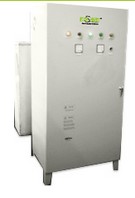Nhà cung cấp: En Bien Import-Export Co., Ltd
Người liên hệ: Mr. AZ. Chung
Chức vụ:
Địa chỉ: 125/22 Hoa Hung street, ward 12, dist 10, HCM city
Quốc gia: Vietnam
Điện thoại: +84-8-3868 3533 - Mobi: +84-909 252 3361
Máy ESI - B500K- Giải pháp tiết kiệm năng lượng
Giá:
ESI - B500K Series Engergy Saving Systems
Ensave Air Compressor saving principle and structure
- Saving Principle
To understand the saving principle of our Ensave system, it will be appropriate if we take an example of one of our customer air compressor’s data. The company's compressor pressure set to: maximum pressure of 0.8Mpa and the lower pressure of 0.53Mpa. For a unit load, the loading time and the unloading time are about 2 / 1. Part of the air compressor’s time works in the unloaded state with low efficiency, and power wastage. At this point the so-called unloading where the compressor is not acting, and in the empty state, and then this part of the energy is wasted. Another reason for the lower limit set at 0.53Mpa, that is the minimum 0.53Mpa gas can be used in production, and the pressure increases from 0.53Mpa to 0.8Mpa (loading) will result in a large wastage of electricity. With our Ensave air compressor dedicated Saver which uses a specially designed pressure control system which sets a reasonable supplies pressure, such as for this case 0.55Mpa. When the system pressure is higher than this pressure, Ensave Saver reduces the compressor’s speed, and then doubled down the compressor power consumption.
When the gas consumption increases, Ensave Saver increases the compressor speed so causing rapid increases in pressure in a short-term. And so achieve two objectives: energy-saving and constant pressure air supply. Meanwhile, the compressor motor starting mode becomes soft starter, which in turn can protect the compressor and the motor, and greatly extended their service life.
At present most of the usage (volume) of the air compressor systems for all production needs is set at the standard in the upper and lower limits. When start running, if the size of the load condition makes air compressors produce more unloading time, the greater the loading and unloading proportion, the more the energy is being wasted. And result in a significant waste of energy. - Ensave air compressor Smart Saver main components:
Ensave air compressor energy saving intelligent controller is a highly intelligent integrated control system. The system comes in a control cabinet. The control unit corresponds to the specific size and power of the motor.
Intelligent Control Unit:
intelligent control unit is the core of the system. It takes a great deal of analysis, calculation and real-time control tasks. It collects the pressure from the pressure information acquisition unit, It conducts a comprehensive analysis and processing, in accordance with the mathematical model of optimal saving and energy saving operation to calculate the speed curve of the motor, and to control the motor speed operation to achieve energy saving. And be able to achieve the needs and requirement of the users to ensure safe, effective, reliable operation.
Electromagnetic control unit:
The system makes use of the electromagnetic voltage regulator, electromagnetic phase, electromagnetic balance technology, and combined with the microcomputer intelligent control circuit. It can monitor real-time changes in the electrical load in accordance with the actual parameters of the current grid and to match the actual needs of the output control power.
Also, the excess energy can be feedback to the grid. This will improve the power factor of the electrical equipment, reduce line losses, improve system power efficiency, increase the line capacity, and improve voltage balancing. Furthermore, reduce the loss of the electrical device, and hence extend the electrical equipment life. Thus, effectively achieve comprehensive system energy-saving and a substantial increase in the power-saving efficiency.
Inverter modules:
The inverter modules control the running speed of the motor with the speed range from 0 to 100%, and the overload ratio of 120 to 150% (one minute duration). The operating frequency or speed signal of the inverter is governed by the intelligent control unit which automatically controls the speed in accordance with the speed - time curve of the motor.
Pressure signal acquisition unit:
Pressure acquisition unit uses imported high-precision
pressure sensor, responsible for the collection and transmission of pressure signal.
Switching power supply:
This device provides high-precision DC power supply to the power-saving controller, and to ensure stable and reliable operation of the control system. - Features
- achieve a constant pressure to the whole system.
- Soft start to reduce the current and mechanical impact, extend equipment life, reduce equipment maintenance cost.
- Improve the system power factor, and power efficiency.
- No need special trained personal to take care, the system is stable, according to need the system will automatic exit.
LIÊN HỆ ĐẶT HÀNG
Vui lòng nhập đầy đủ thông tin của bạn để gửi email
DANH MỤC
















 Nhựa
Nhựa